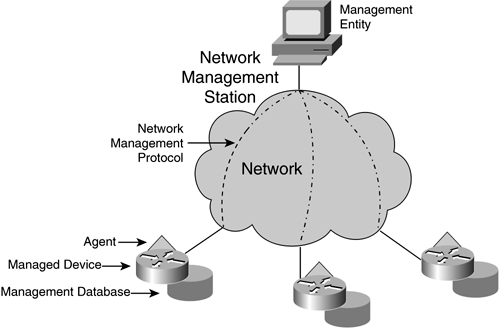Network Management Architecture
The architecture of a network management platform is made up of a common set of relationships and structure that exists between managed devices and a management entity, as illustrated in Figure 18-1.
Figure 18-1. Network Management Topology

The following list details the components found in a network:
End stations Computer systems and network devices with software that enables the sending of alerts (to management entities) when network issues are identified; for example, any LAN server or user's workstation configured with network management software.
Management entities These entities are programmed to react to end-station alerts by executing a predefined set of actions, such as the following:
- Event logging
- System shutdown
- Console notification
- Automatic attempts to repair the system (such as reload or reboot)
The elements of a management system are as follows:
Network manager agents Integrate with network devices, platforms, and applications
Network manager applications Network management servers that collect network management data from the network manager agents and correlate the data for analysis by the network administrator/manager
Network management agents carry network management data and report network transmission problems to a network manager. The network manager controls a set of management agents and ensures that these agents collect the appropriate information.
Network management agents are software modules that compile information about the devices within which they reside and automatically or manually respond to all polls.
Agent information is conveyed to the management entity within the Network Management System (NMS) via a network management protocol, such as Simple Network Management Protocol (SNMP).
EAN: 2147483647
Pages: 269